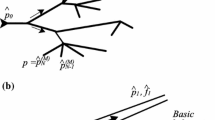Abstract
A solution algorithm yielding the pressure and flow-rate distributions for steady flow in an arbitrary, tree-like network is provided. Given the tree topology, the conductance of each segment and the pressure distribution at the boundary nodes, the solution is obtained from a simple recursion based on perfect Gauss elimination. An iterative solution method using this algorithm is suggested to solve for the pressure and flow-rate distributions in an arbitrary diverging-converging (arterial-venous) network consisting of two tree-like networks which are connected to each other at the capillary nodes. A number of special solutions for tree-like networks are obtained for which the general algorithm is either simplified or can be replaced by closed form solutions of the pressure and flow-rate distributions. These special solutions can also be obtained for each tree of diverging-converging networks having particular topologies and conductance distributions. Sample numerical results are provided.
Similar content being viewed by others
References
Bassingthwaighte, J. B. and J. H. G. M. Van Beek. 1988. Lightning and the heart: fractal behavior in cardiac function.Proc. IEEE 76, 693–699.
Bassingthwaighte, J. B., R. B. King and S. A. Roger. 1989. Fractal nature of regional myocardial blood flow heterogeneity.Circ. Res. 65, 578–590.
Cohn, D. L. 1954. Optimal systems: I. The vascular system.Bull. Math. Biophys. 16, 59–74.
Cohn, D. L. 1955. Optimal systems: II. The vascular system.Bull. Math. Biophys. 17, 219–227.
Dawant, B., M. Levin and A. S. Popel. 1986. Effect of dispersion of vessel diameters and lengths in stochastic networks: I. Modeling of microcirculatory flow.Microvasc. Res. 31, 203–222.
Fenton, B. M. and B. W. Zweifach. 1981. Microcirculatory model relating geometrical variation to changes in pressure and flow rate.Ann. Biomed. Engng. 9, 303–321.
Fung, Y. C. 1984.Biodynamics: Circulation. Berlin: Springer-Verlag.
Fung, Y. C. 1991. Dynamics of blood flow and pressure-flow relationship. InThe Lung: Scientific Foundation. R. G. Crystal et al. (Eds). New York: Raven Press.
Gan, R., Z. Y. Tian, R. T. Yen and G. S. Kassab. 1993. Morphometry of the dog pulmonary venous tree.J. Appl. Physiol. 75, 432–440.
Glenny, R. W. and H. T. Robertson. 1991. Fractal modeling of pulmonary blood flow heterogeneity.J. Appl. Physiol. 70, 1024–1030.
Horsfield, K. 1990. Diameters, generations, and orders of branches in the bronchial tree.J. Appl. Physiol. 68, 457–461.
Horsfield, K. 1991. Pulmonary airways and blood vessels considered as confluent trees. InThe Lung: Scientific Foundation. R. G. Crystal et al. (Eds). New York: Raven Press.
Horton, R. E. 1945. Erosional development of streams and their drainage basins; hydrophysical approach to quantitative morphology.Bull. Geol. Soc. Am. 56, 275–370.
Hydon, P. E. 1993. How to solve linear equations in branching networks. Unpublished.
Jiang, Z. L., G. S. Kassab and Y. C. Fung. 1994. Diameter-defined Strahler system and connectivity matrix of the pulmonary arterial tree.J. Appl. Physiol. 76, 882–892.
Kassab, G. S., C. A. Rider, N. J. Tang and Y.-C. B. Fung, 1993. Morphometry of pig coronary arterial trees.Am. J. Physiol. 265, H350-H365.
Liao, K. H. and A. E. Scheidegger. 1968. A computer model for some branching-type phenomena in hydrology.Bull. Inf. Assoc. Int. Hydrol. Sci. 13, 5–13.
Lipowsky, H. H. and B. W. Zweifach. 1974. Network analysis of microcirculation of cat mesentery.Microvasc. Res. 7, 73–83.
Lipowsky, H. H. 1986. Network hemodynamics and the shear rate dependency of blood viscosity. InMicrovascular Networks: Experimental and Theoretical Studies. A. S. Popel and P. C. Johnson (Eds), pp. 182–196. Basel: Karger.
Mayer, S. 1994. On the pressure and flow-rate distributions in networks. Ph.D. thesis, University of California, San Diego.
Mayrovitz, H. N., M. P. Wiedeman and A. Noordergraaf. 1975. Microvascular hemodynamic variations accompanying microvessel dimensional changes.Microvas. Res. 10, 322–339.
Murray, C. D. 1926. The physiological principle of minimum work. I. The vascular system and the cost of blood volume.Proc. Nat. Acad. Sci. USA 12, 207–214.
Parter, S. 1961. The use of linear graphs in Gauss elimination.SIAM Rev. 3, 119–130.
Popel, A. S. 1980. A model of pressure and flow distribution in branching networks.J. Appl. Mech., Trans. ASME 47, 247–253.
Popel, A. S. 1987. Network models of peripheral circulation. InHandbook of Bioengineering. R. Skalak and S. Chien (Eds), pp. 20.1–20.24. New York: McGraw-Hill.
Singhal, S., R. Henderson, K. Horsfield, K. Harding and G. Cumming. 1973. Morphometry of the human pulmonary arterial tree.Circ. Res. 33, 190–197.
Strahler, A. N. 1957. Quantitative analysis of watershed geomorphology.Trans. Am. Geophys. U. 38, 913–920.
Sud, V. K. and G. S. Sekhon. 1990. Steady flow of a viscous fluid through a network of tubes with applications to the human arterial system.J. Biomech. 23, 513–527.
Weibel, E. R. 1991. Design of airways and blood vessels considered as branching trees. InThe Lung: Scientific Foundation R. G. Crystal et al. (Eds). New York: Raven Press.
Woldenberg, M. J. 1986. Quantitative analysis of biological and fluvial networks. InMicrovascular Networks: Experimental and Theoretical Studies. A. S. Popel and P. C. Johnson (Eds), pp. 12–26. Basel: Karger.
Yen, R. T., F. Y. Zhuang, Y. C. Fung, H. H. Ho, H. Tremer and S. S. Sorbin. 1983. Morphometry of cat pulmonary venous tree.J. Appl. Physiol. 55, 236–242.
Yen, R. T., F. Y. Zhuang, Y. C. Fung, H. H. Ho, H. Tremer and S. S. Sobin. 1984. Morphometry of cat's pulmonary arterial tree.J. Biomech. Engng. 106, 131–136.
Zhuang, F. Y., Y. C. Fung and R. T. Yen. 1983. Analysis of blood flow in cat's lung with detailed anatomical and elasticity data.J. Appl. Physiol. 55, 1341–1348.
Author information
Authors and Affiliations
Rights and permissions
About this article
Cite this article
Mayer, S. On the pressure and flow-rate distributions in tree-like and arterial-venous networks. Bltn Mathcal Biology 58, 753–785 (1996). https://doi.org/10.1007/BF02459481
Received:
Accepted:
Issue Date:
DOI: https://doi.org/10.1007/BF02459481




